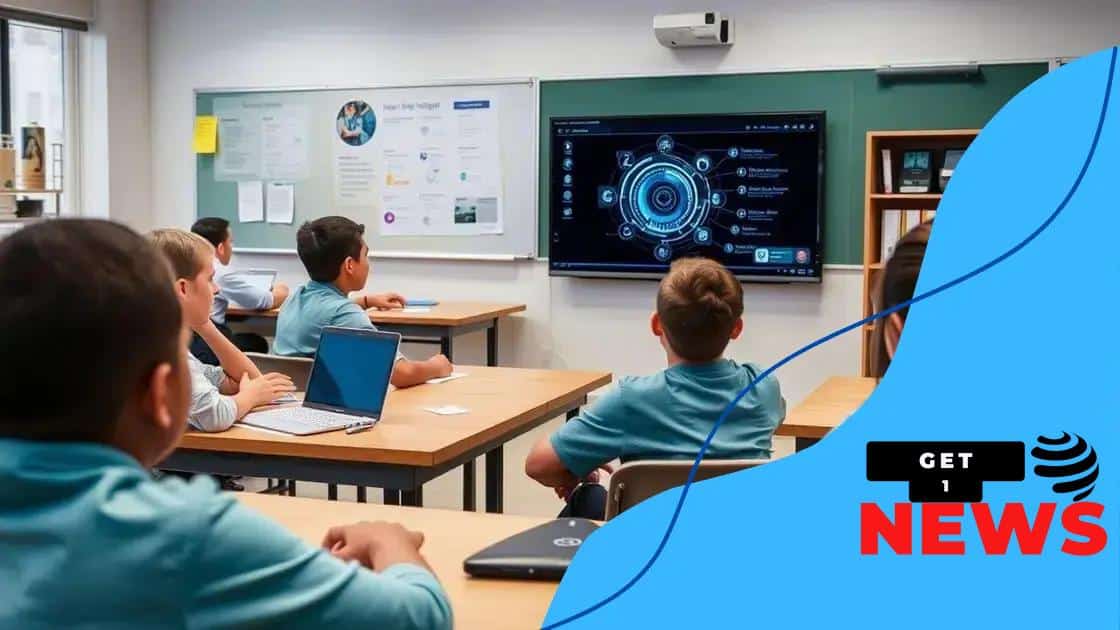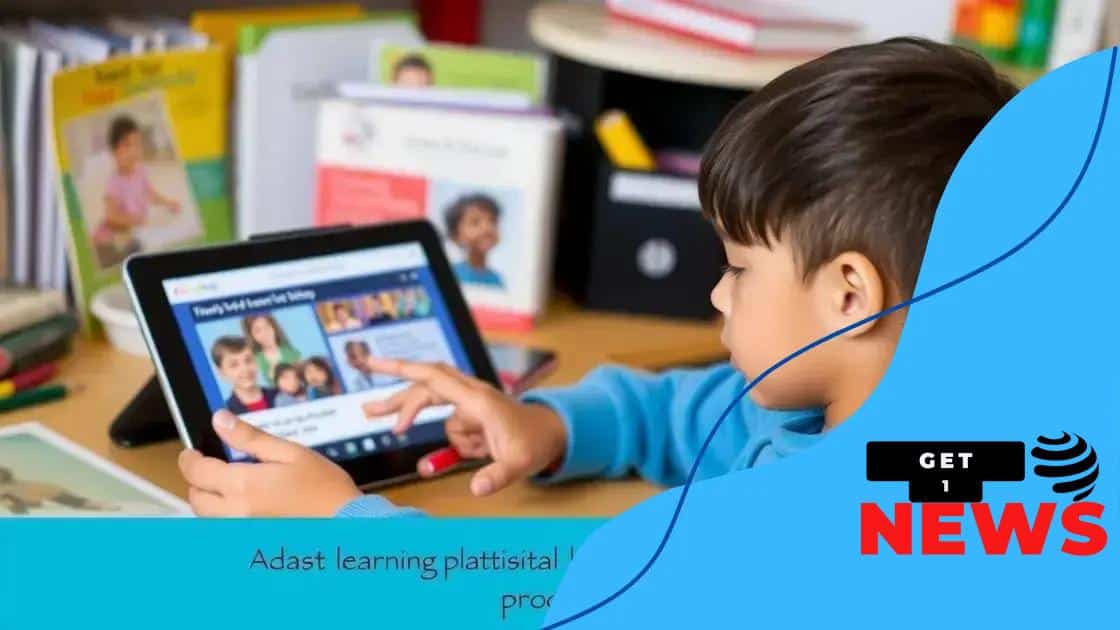AI tracking student engagement: boost learning outcomes

AI tracking student engagement enhances personalized learning by adapting educational content to individual needs, providing real-time feedback, and fostering interactive environments, thereby significantly improving student outcomes in classrooms.
AI tracking student engagement is transforming the educational landscape. Have you ever wondered how technology can enhance the learning experience? This article delves into its impact on classrooms today.
Understanding AI tracking in education
Understanding AI tracking in education involves exploring how technology is shaping the way teachers interact with students. It provides insights into student behaviors, engagement, and learning trends that were previously difficult to measure.
By utilizing AI tools, educators can gain a deeper understanding of how their students learn. This analytical approach can help identify which teaching methods resonate most with learners and adjust strategies accordingly.
Key Features of AI Tracking
AI tracking leverages data analytics and machine learning to provide real-time feedback. Here are some key features:
- Data Collection: AI systems gather data from various sources, including online assignments and classroom interactions.
- Engagement Metrics: They analyze student engagement through activities like participation in discussions and time spent on tasks.
- Personalized Learning: Insights allow for tailored learning experiences based on individual student needs.
These features empower teachers to create responsive learning environments. For instance, if a student is struggling with a particular concept, AI can suggest additional resources. This timely intervention can make a significant difference in a student’s understanding and retention of material.
The Role of Data in Education
The integration of data into educational practices is essential. AI tracking tools help educators see patterns over time, revealing areas of strength and weakness. Instead of relying on sporadic tests, teachers can observe ongoing progress.
Moreover, these insights facilitate data-driven decision-making. By understanding trends in student performance, schools can allocate resources more effectively. For example, if the data indicates that a significant number of students struggle with math, the school may implement additional tutoring sessions to address this issue.
This approach ultimately leads to a more informed educational environment where decisions are based on reality rather than assumptions. As AI tracking continues to evolve, the potential for more significant improvements in student outcomes increases.
Benefits of AI for student engagement
The benefits of AI for student engagement are becoming increasingly evident in today’s classrooms. Schools are adopting AI technologies to enhance learning experiences and provide personalized support for students.
One of the main advantages is that AI tools can create individualized learning paths. They analyze student performance and adapt resources to meet each learner’s unique needs. This tailored approach helps students stay motivated and engaged in their studies.
Improved Interaction
AI tools also foster better interaction between students and educators. With platforms that track engagement levels, teachers can identify who may need extra help or encouragement. This means they can provide targeted assistance when it’s needed most.
- Real-time data: Teachers receive immediate insights into how students are responding to lessons.
- Feedback mechanisms: AI facilitates ongoing feedback, helping students understand their strengths and weaknesses.
- Enhanced communication: Messaging features in educational apps promote dialogue between students and teachers.
Additionally, analytics from AI platforms can help educators understand broader trends in classroom engagement. By observing patterns, they can adjust teaching styles to align with what resonates most with their students.
Increased Motivation
AI for student engagement also provides gamified learning experiences. Incorporating elements like rewards and challenges can boost student motivation. When students are actively involved and enjoy what they are doing, learning becomes more effective.
For instance, platforms that use adaptive learning techniques can present challenges that are neither too difficult nor too easy. This balance keeps students engaged and encourages a growth mindset.
Moreover, AI can support collaborative learning by connecting students with similar interests. By facilitating group projects and discussions, students feel more connected and engaged in their learning journey.
How AI can personalize learning experiences

AI can personalize learning experiences by tailoring educational content to meet individual student needs. This personalization helps students learn at their own pace, leading to better outcomes.
One way AI achieves this is through adaptive learning technologies. These systems analyze a student’s strengths and weaknesses and modify the curriculum accordingly. For example, if a student struggles with math, the AI can provide additional resources and exercises focused on that area.
Benefits of Personalized Learning
The benefits of personalized learning through AI are significant. Students feel more engaged when they learn in ways that suit their style. Here are some key advantages:
- Increased Engagement: Tailored content grabs students’ attention and encourages them to participate more actively.
- Improved Understanding: By focusing on areas where they need help, students can master concepts more effectively.
- Confidence Boost: As students progress through personalized learning paths, their confidence grows with each accomplishment.
Moreover, AI can analyze student data to predict future learning needs. This means that educators can prepare students for what comes next, ensuring they are always challenged yet supported.
Real-time Feedback and Support
With AI, students receive real-time feedback on their work. This immediate response allows them to understand mistakes and learn from them right away. It’s different from traditional methods where feedback is often delayed.
Additionally, AI tools can offer suggestions for improvement and additional resources based on performance. This kind of support empowers students to take charge of their learning journey.
Ultimately, the combination of tailored content and real-time feedback creates a dynamic learning environment where every student has the opportunity to thrive.
Challenges of implementing AI in classrooms
Implementing AI in classrooms presents several challenges that educators must navigate. While technology offers significant potential, understanding these obstacles is crucial for successful integration.
One major challenge is the training of teachers. Many educators are not familiar with AI technologies and may feel overwhelmed by new tools. Providing adequate training and ongoing support is essential to ensure teachers can effectively use these tools in their instruction.
Technical Issues
Another significant hurdle is the technical infrastructure required for AI systems. Schools must have reliable internet access and the necessary hardware to support AI applications. Without these components, AI tools may not function as intended.
- Cost: Acquiring AI technologies can be expensive for some schools, especially those on a tight budget.
- Integration: Existing curricula often need to be adapted to incorporate AI tools, which can take time and resources.
- Maintenance: Regular updates and maintenance of AI systems are essential to keep them running smoothly.
Moreover, data privacy concerns also arise. Collecting and analyzing student data requires strict adherence to privacy laws. Schools must ensure they protect sensitive information while utilizing AI insights effectively.
Resistance to Change
Resistance to change can also impede the adoption of AI. Some educators and stakeholders may be skeptical about the benefits of AI technology. Overcoming this skepticism requires clear communication about the advantages of using AI in the classroom.
Additionally, there’s a fear that AI could replace traditional teaching roles. However, AI is meant to support educators, not replace them. Addressing these concerns involves illustrating how AI can enhance teaching and provide valuable feedback for both students and teachers.
Ultimately, while the challenges of implementing AI in classrooms may seem daunting, with proper planning and support, schools can harness the power of AI to improve educational outcomes.
Future of AI in educational engagement
The future of AI in educational engagement looks promising as technology continues to advance. Schools are exploring innovative ways to improve learning outcomes through AI applications that adapt to individual student needs.
In coming years, we can expect AI to play a more integrated role in classrooms. With tools that provide real-time analytics, educators can personalize learning experiences more effectively. By understanding each student’s unique challenges, teachers can offer targeted support.
Enhanced Learning Environments
Furthermore, AI is likely to create more engaging learning environments. Interactive platforms will make learning fun and immersive. Students will have access to virtual reality (VR) experiences that enhance understanding through simulation.
- Adaptive Learning: Future AI systems will become even smarter, continuously adapting to the changing needs of students.
- Collaboration Tools: AI will facilitate collaborative projects among students, fostering communication and teamwork.
- Skill Development: Emphasizing skills like critical thinking and creativity will be central as AI continues to evolve.
These advancements will not only boost student engagement but also prepare them for the future workforce. As industries evolve, skills learned in school will be directly applicable to real-world challenges.
Data-Driven Insights
The use of AI will also provide invaluable data-driven insights. Teachers will have access to rich data about student performance, allowing them to refine their teaching strategies. This will create a feedback loop where continuous improvement is possible.
Additionally, as AI tools become more widespread, they will democratize education. Access to quality resources and personalized support will be available to a broader range of students, regardless of their location.
As we look to the future, the potential for AI in educational engagement is immense. The combination of advanced technology and thoughtful pedagogy will undoubtedly shape the next generation of learners.
The future of AI in education presents exciting opportunities for enhancing student engagement. As schools adopt AI technologies, personalized learning experiences will become more prevalent. With better tools and data-driven insights, teachers can meet individual needs more effectively. However, challenges such as training, technical infrastructure, and data privacy concerns must be addressed. By tackling these issues, we can ensure that all students benefit from these innovations. The journey ahead is promising, with AI poised to transform classrooms into dynamic and interactive learning environments.
FAQ – Frequently Asked Questions about AI in Education
How can AI enhance student engagement?
AI can make learning more personalized by adapting to individual student needs, keeping them engaged and motivated.
What challenges do schools face when implementing AI?
Schools may struggle with training teachers, ensuring adequate technical infrastructure, and addressing data privacy concerns.
How does AI provide real-time feedback?
AI systems analyze student performance instantly, allowing teachers to offer timely support and resources based on current needs.
What is the future of AI in classrooms?
The future of AI in education includes more interactive and engaging learning environments, as well as improved data insights for teachers.





